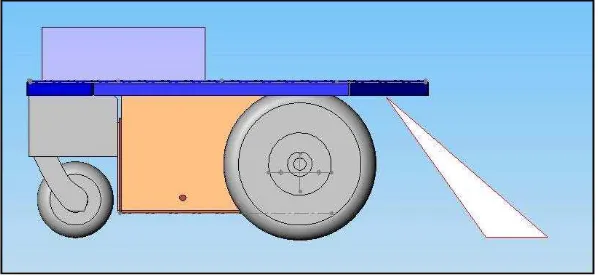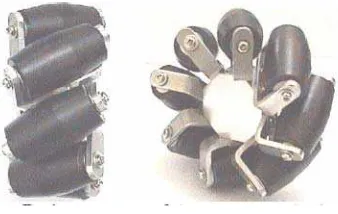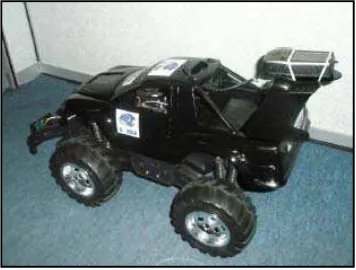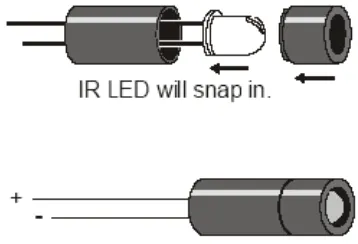MOBILE ROBOT MULTIPLE SENSOR BEHAVIOUR FOR OBSTACLE AVOIDANCE
Abdul Razak bin Abdul Rahman
Bechelor of Electrical Engineering (Power Industry)
i
“ I hereby declare that I have read through this report entitle “Mobile Robot Multiple Sensor Behavior for Obstacle Avoidance” and found that it has comply the partial fulfillment for awarding the degree of Bachelor of Electrical Engineering (Industrial Power)”
ii
MOBILE ROBOT MULTIPLE SENSOR BEHAVIOR FOR OBSTACLE AVOIDANCE
ABDUL RAZAK BIN ABDUL RAHMAN
A report submitted in partial fulfillment of the requirements for the degree of Electrical Engineering (Industrial Power)
Faculty of Electrical Engineering
UNIVERSITI TEKNIKAL MALAYSIA MELAKA
iii
I declare that this report entitle “Mobile Robot Multiple Sensor Behavior for Obstacle Avoidance” is the result of my own research except as cited in the references. The report has not been accepted for any degree and is not concurrently submitted in candidature of any other degree.
Signature : ………
Name : ………
iv
ACKNOWLEDGMENT
Assalamualikum Warahmatullah Wabarakatuh.
Praise to Allah s.w.t, The All Mighty that give me the strength to finish and complete this report on time. Praise to Allah s.w.t for without His blessing this report would not have been completed.First of all would like to thank my parents who had been helping, motivating, and supporting me from the very beginning to the end in order to complete final project.
I also would like to thanks University Technical Malaysia, Melaka especially the Electrical Engineering faculty, for giving me the chance to be creative and innovation in our electrical component. With this opportunities, it’s give me more understanding with our electrical concept and learn how’s to thinking and build something new equipment that can give easier than before.
v
ABSTRACT
vi
ABSTRAK
vii
TABLE OF CONTENTS
CHAPTER TITLE PAGE
ACKNOWLEDGEMENT iv
ABSTRACT v
TABLE OF CONTENTS vii
LIST OF TABLES x
LIST OF FIGURES xi
LIST OF APPENDICES xiii
1 INTRODUCTION 1
1.1 Background 1
1.2 Problem statement 1
1.3 Objectives 3
1.4 Scope 3
2 LITERATURE REVIEW. 4
2.1 Mobile Robot 4
2.2 Sensor 7
2.2.1 Ultrasonic sensor 7
2.2.2 Infrared sensor 8
2.3 Microcontroller 10
2.4 Mobile Robot Design for This Project 11
3 RESEARCH METHADOLOGY. 12
viii
4 PROJECT DEVELOPMENT 20
4.1 Hardware development 20
4.1.1 Mobile robot structure 20
4.1.2 Shaft design 21
4.2 Electrical development 23
4.2.1 Relay circuit 23
4.2.2 Relay circuit operation 23 4.2.3 Limit switch operation 25 4.2.4 Sensor operation 26
4.3 Software development 27
4.3.1 CCS C compiler. 27
4.3.2 Proteus software 30
4.3.3 Import Hex file 30
5 RESULT ANALYSIS 32
5.1 Without sensor analysis 32 5.1.1 Forward and backward movement 32
5.1.2 Data analysis 34
5.1.3 Three hundred and sixty 35 degree (360⁰) rotation
5.1.4 Data analysis. 37 5.1.5 Ninety degree (90⁰) turns 38 5.2 Number eight formation analysis. 41
5. 2.1 Complete task 42
5.2.2 Data analysis 43
5.3 Sensor analysis 44
5.3.1 Analysis process. 46
5.3.2 Data Analysis 47
ix
6 DISCUSSION AND CONCLUSION. 49
6.1 Conclusion. 49
6.2 Recommendation 49
REFERENCES 50
APPENDICES 52
x
LIST OF TABLES
TABLE TITLE PAGE
5.1 Analysis result and data taken for forward 32 and backward movement
5.2 Analysis result and data taken for rotation on 35 clockwise and anti clockwise.
5.3 Analysis result and data taken for mobile robot turn. 39 5.4 Analysis result and data taken for mobile robot 42 complete the task.
xi
LIST OF FIGURES
FIGURE TITLE PAGE
Figure 1.1 Mobile robot application. 2
Figure 2.1 Example of Mobile Robot design. 4
Figure 2.2 Omni wheel application. 5
Figure 2.3 Omni wheel design 5
Figure 2.4 Mobile robot structures. 6
Figure 2.5 Ultrasonic sensor design. 8
Figure 2.6 The IR sensors with its cover. 9
Figure 2.7 Mobile robot designs with microcontroller. 11
Figure 3.1 Research Methodology. 14
Figure 3.2 Mechanical hardware construction. 15
Figure 3.3 Electrical hardware construction. 16
Figure 3.4 Software development. 18
Figure 3.5 ADC simulation test on Proteus. 19
Figure 3.6 Relay control simulation tested on Proteus. 19
Figure 4.1 Mobile robot structures. 21
Figure 4.2 Draft design of shaft. 21
Figure 4.3 Complete shafts. 22
Figure 4.4 Shaft connected with motor. 22
Figure 4.5 Relay circuit diagram. 24
Figure 4.6 Relay circuit. 24
Figure 4.7 Bumper with limit switch. 25
Figure 4.8 Ultrasonic sensors. 26
Figure 4.9 New wizards on CCS C compiler and named the file. 27
Figure 4.10 PIC’s setting. 28
Figure 4.11 Analog to digital (ADC) setting. 28
xii
Figure 4.13 Circuit constructs using Proteus software. 30 Figure 4.14 Import hex file the simulation testing. 31 Figure 5.1 Comparison between forward and backward data. 33 Figure 5.2 Time (sec) and data taken to complete the rotation on clockwise. 36
andanticlockwise.
Figure 5.3 Mobile robot turn. 38
xiii
LIST OF APPENDICES
APPENDIX TITLE PAGE
A Planning schedule. 52
1
CHAPTER 1
INTRODUCTION
1.1 Background
Mobile Robot can be classified into a few types based on the application and task
given to complete. Mobile robot with multiple sensor behavior for obstacle avoidance is
one of the autonomous mobile robot types. This robot can perform the tasks without any
guidance from human and but limited to environment structured [1]. In the autonomous
mobile robot designed, the most important is the position of the sensor attached to the
robot. These sensors are act as an eye for alls mobile robot designed where it was used to
decide the direction of the wheel and based on the task given.
However, autonomous mobile robot cannot operate smoothly with sensor only. It
should have a controller that act as a heart where the controller will control the whole
operation of the mobile robot based on program installed [2].Basically, positioning of
sensor is the most difficult part in autonomous mobile robot designed depends on sensors’
specifications and the sight where needs to give strictly attentions. If the research of the
sensor ranges is studied, determination of the movement on left or right will totally affect
to the whole operation of mobile robot [3].
1.2 Problem statement
Why we need the mobile robot? In this era of scientific and technological advance,
people are inclining more and more towards using new devices and system to make sure all
the work is easier and faster. With autonomous mobile robot the hazardous or dangerous
The m
own d
differe and im robot i sensor be pla surrou object avoid is base planni efficie mobile robot dimensions. ent environm mmobile obs
in the real lif
What impo
r uses and it
ace in a bet
unding and e
ts and obstac
collapsed. In
ed on surrou
ing level [5]
ency.
also can tran
Nowadays,
ment that are
stacles [4]. F
fe.
Fig
ortant of sen
ts’ position i
tter location
environment
cles and this
n navigation
unding infor
]. Else too m
nsport mater
mobile rob
e often clutt
Figure 1.1 sh
gure 1.1: Mo
nsors and se
in mobile ro
where the
t needs to a
s is the most
n and in unk
rmation proc
many senso
rial or tools
bot have bee
tered with l
hows ones o
obile robot ap
ensors’ locat
obot designs
range of se
analyses by
t important s
known terrain
cessing is us
rs used will
over distanc
en assigned
ots of know
of the most a
pplication.
tion in robo
is the majo
ense can be
measure th
source inform
n exploration
sed common
l increase th
ces much lar
d to work in
wn and unkn
applications
ot design? T
or problem. S
fully utiliz
e robot dist
mation that
n, the kind o
nly in roboti
he designed
rger than the
n a certain
nown, movin
of the mobi
he number
Sensor shou
ed. A robot
tance to oth
must know
of control th
ics at the tas
3
1.3 Objectives
This project was design based on the following objectives, which are:
1. To design a mobile robot that can avoid the obstacle.
2. To use a microcontroller as a main controller to control the movement of the robot.
1.4 Scope
In order to complete this project, the process is divided into few scopes as follows:
1. The work involves in this project is to design and to fabricate the mechanical and
electronic hardware for a prototype of mobile robot. This task includes the design
of robot structure/base, microcontroller and sensors circuit.
2. To study the sensor behavior and create an algorithm for the movement of mobile
robot in applying the sensor behavior.
3. To use a PIC16F877A as a main controller or robot brain.
4
CHAPTER 2
LITERATURE REVIEW.
2.1 Mobile Robot
Mobile robot design is about art and individual skill to create the useful robot for
human application. Each part of mechanical, electrical and software should be studies to
make sure that the alls mobile robot application can run smoothly and can complete the
task given. In mechanical part, each measurement of the mobile robot design must be
details and fixed to make sure that the cost is not changes and affect to the whole process
design. In electrical and software part also need research because the price is quite
expensive and more sensitive if compare with the mechanical. Each equipment
specification must be study details from it design, application and until the prices [9].
Figure 2.1 shows the example of mobile robot design with the range covered by sensor.
5
Van-Quyet Nguyen et al studies about obstacle avoidance of mobile robot where is
include about the design and the operation. On hardware design, they used the control
software, out-case covers, aluminum beams and plastic connectors, scooter wheels, two
stepper motors, and a power module, a battery (12V, 7A). On his paper stated that the
design is most suitable on the application of their mobile robot. [1].
Jefri Efendi Mohd Salih et al.studies the designed of Omni-Directional Mobile
Robot with Mecanum Wheel. They state that each of individual wheel direction and speed
can be combined and will produces the bizarre results where is can allowed the freely
movement in the direction without changing direction of the wheel [2]. Figure 2.2 shows
the Omni wheel applied in mobile robot designed by Jefri Efendi Mohd Salih, which gives
better turning either to right or left but robot movement a bit slower due to Omni wheel’s
characteristic as shown in Figure 2.3.
Figure 2.2: Omni wheel application.
6
MHA Hamid, AH Adom, NA Rahim, MHF Rahiman in studies about navigation of
mobile robot using global positioning system (GPS) and obstacle avoidance system with
commanded loop daisy chaining application method mobile robot for experiment utilized
the use of remote control (RC) truck with the dimension of 50 cm in length, 25 cm in width
and 15 cm in height. The RC truck include with four independent motor that can actuated
individually which can skid steer to turn the mobile robot in immediate 360 degree turn.
Equipped with seal lead acid battery, mobile robot increases the capability to move in
longer time. Figure 2.4 show mobile robot structures integrated with GPS and sonar sensor
[3].
Figure 2.4: Mobile robot structures.
Meng Joo Er and Chang Deng studies about obstacle avoidance of a mobile robot
using hybrid learning stated that the Khepera robot used is cylindrical in shape, measuring
55 mm in diameter and 30 mm in height. Its weight is only 70 g. They also state that the
small size allows experiments to be performed in a small work area [4].
Johns Hopkins on paper designing an autonomous robot vehicle stated that the
body of the car contained two major parts which is the chassis and the arm. Their mobile
robot design used entire vehicle fit into a 12 inch by 12 inch square that was no more 42
than 14 inches high. The chassis was made up of an upper stage and a lower stage. The
upper stage was made of clear Plexiglas, which was cut to fit a 12 inch by 12 inch square
7
2.2 Sensor
2.2.1 Ultrasonic sensor
William et al. had studies about implementation of a binaural sensory pod using an
ultrasonic emitter and two receivers on a legged robot. A series of obstacle avoidance
behavior is programmed onto a microcontroller that allows the robot to move both
semi-autonomously and semi-autonomously successfully programmed. From his studies, binaural
ultrasonic sensor pod and programmed avoidance behavior has proven itself useful as a
mobile robot navigation aid. By using the modular design implemented for these
experiments, the sensor pods could be integrated with other mobile robots to provide
non-contact sensing and navigation for them as well. [6].
J. Borenstein et al.on their paper about Mobile Robot Positioning & Sensors and
Techniques had briefly described and defined that the seven categories for positioning
systems where are Odometry, Inertial Navigation, Magnetic Compasses, Active Beacons,
Global Positioning Systems, Landmark Navigation, and Model Matching. Each categories
had their own characteristic and specialize like can make measurement of distance by the
position, radius, x and y axis and more characteristic. [7].
Jarosław Majchrzak, Mateusz Michalski, and Grzegorz Wiczyn´skion Distance
Estimation With a Long-Range Ultrasonic Sensor System had successfully identified a
fundamental factor on the measuring error that always occurs on the mobile robot sensor
that is because environmental conditions. To avoid this problem than occurred, a
proposition of the distance measuring procedure with the chosen estimator is presented.
The proposed measurement procedure could be useful when dealing with problems
concerning the reliability of the measurement results obtained with ultrasonic sensors. It
could be used as an alternative to other statistics-based methods. The proposed estimator
chosen based on the of an error analysis for measurements performed in the range [8].
8
Figure 2.5: Ultrasonic sensor design.
2.2.2 Infrared sensor
Shadia Elgazzar and Timothy Welch stated that the sonar sensor can act and
working as ultrasonic sensor application. It also can determine the distance between the
sensors and object sharply and it also more cheaper compared to the ultrasonic sensor.
Even it was cheaper and can operate similarly like an ultrasonic sensor, but the range
coverage of infrared sensor only can reach until 3meters maximum compare with
ultrasonic where can reach until 6 meters. This showed that the infrared are most suitable
in the small application of mobile robot than using ultrasonic sensor [9].
Shih-Jie Chang, and Wei Tong have identified the infrared sensor transmitter and
receiver can use in two mobile robots with different application, which they had proposed
a fuzzy target tracking control technique in their autonomous mobile robot. The first one
can use as follower to the first mobile robot and another ones are use as a target tracking
9
Jose Vazquezand Chris Malcolm in their studies mention that the maximum range
of the infrared sensor is three meters with the beam width 450. The laser ranging is usually
not used because the price is most expensive compared to infrared. In the research, the
extract features from sonar sensors based on triangulation plus infrared sensing have been
implemented successfully [11].
Heon-Hui Kim Yun-Su Ha Gang-Gyoo Jin on a studies about the Environmental
Map Building for a Mobile Robot Using Infrared Range-finder Sensors stated that the
sensor adopted for this work is infrared range-finder PB9-01 manufactured by HOKUYO
AUTOMATIC, which uses an infrared LED modulated at 87ohm for signal generation. It
not only has compact size and light weight but also gets distant and directional information
to an object for one time scanning [12].
Matijevics studied about Infrared Sensors Microcontroller Interface System for
Mobile Robots stated that the IR sensor consists IR LED emitter and photo sensitive
transistor Photo-transistor is in a plastic house with filter for daylight. LED is in series
connection with resistor and controlled over the microcontroller out pin. There are two IR
sensors in front of robot. The IR sensor is used with 980 nm wavelength light [13]. Figure
2.6 shows the IR sensor with its cover.
10
2.3 Microcontroller
MHA Hamid et al. studied about Navigation of Mobile Robot Using Global
Positioning System (GPS) and Obstacle Avoidance System with Commanded Loop Daisy
Chaining Application Method stated the mobile robot for their project is suitable used
micro controller in Basic stamp BS2 and BS2p. For BS2 it offer processor speed 20 MHz
and it can execute approximately 4000 instruction per second. RAM size for BS2 is 32
bytes and 2K bytes memory for EEPROM about 500 instructions can be store in flash
memory [13].
Chan Zhi Wei and Muhammad Nasiruddin Mahyuddin studied about Neuro-Fuzzy
Algorithm for Obstacle Avoidance Mission of a Mobile Robot Using FPGA discussed that
the designed obstacle avoidance program for mobile robot that incorporates a neuro-fuzzy
algorithm using Altera Field Programmable Gate Array (FPGA) development board. Field
Programmable Gate Array (FPGA) circuits provide suitable platform in realizing complex
hardware system as well as implementing data intensive algorithm computation. The
ability to easily reconfigure FPGA makes the design less expensive than pre-designed
hardware. These features bring convenience to incorporating an artificial
intelligence-based-program for mobile robot navigation and obstacle avoidance task or mission [3].
Johns Hopkins University studied on designing an autonomous robot vehicle stated
that the microcontroller used as the central control system for the vehicle was the Motorola
68HC11. It has many features, including five I/O ports, five internal, independent timers
that can be programmed to provide pulse width modulation and an on-board analog to
digital converter. The 68HC 11 can also be easily interfaced with different external circuits





